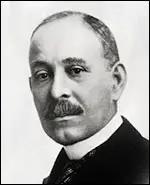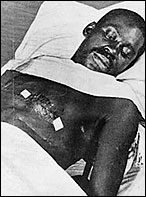Black Lightning
Superstar

Bessie Blount was an African American woman who led a life that was dedicated to helping those in need. She was a physical therapist and an inventor of apparatus that was designed to help the amputees that suffered permanent injuries in World War II. Bessie Blount has been called a "savior of the handicapped" for her invention that allowed World War II disabled veterans to feed themselves, and for her unique method of teaching them to write again.

Frederick McKinley Jones is credited with transforming the food industry and America's eating habits with his invention of a practical refrigeration system for trucks and railroad cars. Frederick Jones patented more than sixty inventions in all, but it is his invention of the automatic refrigeration system for long-haul trucks in 1935 that he is most famous for.
Roscoe L Koontz designed a pinhole gamma ray camera called the collimator, and helped to design and fabricate automatic air and water radiation activity measuring devices. He was the first formally trained health physicist.
Health physics is a profession devoted to the protection of people and the environment from the harmful effects of radiation, thus providing for the utilization of radiation for the benefit of mankind. The profession, as we know it, began during World War II when the tremendous power available from nuclear energy was first being developed for weapons. The radiation hazards encountered during the early years of atomic energy were solved by the cooperation of physicists, chemists, biologists, engineers, and physicians. From this endeavor emerged the interdisciplinary specialty known as "health physics."

Jan Ernst Matzeliger invented a shoemaking machine that increased shoemaking speed by 900%. Jan Matzeliger conceived, patented, built working models, and factory-tested a machine known as a shoe-lasting machine, and he eventually became a stockholder in the company that manufactured it. Matzeliger's shoe-lasting machine could produce 150 to 700 pairs of shoes a day.

Elijah McCoy was the inventor of a device that allowed machines to be lubricated while they were still in operation. Machinery buyers insisted on McCoy lubrication systems when buying new machines and would take nothing less than what became known as the real McCoy. The inventor's automatic oiling devices became so universal that no heavy-duty machinery was considered adequate without it, and the expression became part of America culture.

Louis W. Roberts was a pioneer in optics and microwave electronics technology. He was also one of the highest-ranking African-American scientists working for NASA during our race to the moon. Roberts holds eleven patents for electronic devices and is the author of papers on electromagnetism, optics, and microwaves.

James Edward West, Ph.D., is a Bell Laboratories Fellow at Lucent Technologies where he specializes in electro, physical, and architectural acoustics. James West's research in the early 1960s led to the development of foil-electret transducers for sound recording and voice communication that are used in 90% of all microphones built today and at the heart of most new telephones being manufactured.






 #NoLosses
#NoLosses
 feeling was a reason why.
feeling was a reason why.


